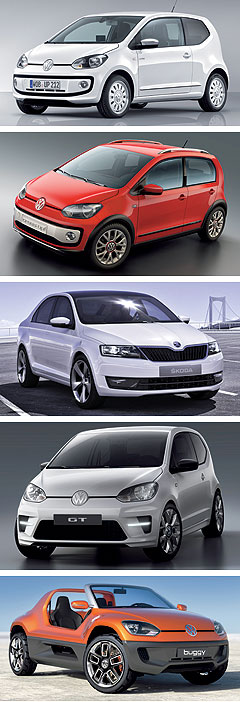Skoda attempts to grow by shrinking with the Citigo
BY MIKE COSTELLO | 28th Sep 2011

Like the Up, Skoda’s Citigo will eventually be available in three- and five-door guises, and is scheduled to hit showrooms across its Czech Republic home by the end of this year before becoming available across the rest of Europe in the second quarter of 2012.
Its Australian future remains unclear, with Skoda spokesman Karl Gehling telling GoAuto that the Citigo is "under consideration" for the local range, in which it would slip beneath the recently released Fabia as the entry-level model.
British magazine Autocar has speculated that the Citigo will retail for around £7000 ($A11,400) in the UK, while Volkswagen looks set to sell the Up from under $15,000 when it launches here.
Cosmetic differences between the three-door Citigo and its Up sister car include the straight-edged rear window line, signature finned Skoda front grille design and subtly revised headlights.
Skoda has not yet released images of the promised five-door variant, although Volkswagen revealed a near-production five-door version of the Up at the recent Frankfurt motor show, dubbed the Cross Up.
At just 3563mm long, 1641mm wide and with a height of 1478mm, the diminutive three-door Citigo shares dimensions with the equivalent Up variant.
The car’s kerb weight (including a 75kg driver) is 929kg and the design is similarly aerodynamic to the Up with a drag coefficient of 0.33Cd.
This tall-boy design, along with the car’s relatively long wheelbase of 2420mm, gives it a sizeable 251 litres of boot volume with the seats reclined and an even more impressive 951 litres when the rear pews are folded flat.

Interior features include numerous storage compartments, including pockets on the side of the front seats, a bag hook attached to the glovebox handle and a photograph holder on the centre console.
While Skoda has not yet released pictures of the interior, the company says it will feature a “high level of quality and precision in its design” and feature the brand’s first portable navigation system that can be can be removed from the dash and used on the go.
Just like the system in the Up, the device also controls the car’s Bluetooth connectivity, in-car information and infotainment via its five-inch touchscreen.
The diminutive car will debut with the Volkswagen Group’s new-generation 1.0-litre, three-cylinder petrol engine in two different states of tune – with 44kW and 55kW of power and claimed fuel use of 4.5 litres per 100km and 4.7L/100km respectively – mated exclusively to a five-speed manual transmission.
The more powerful of the two engines emits 108 grams of carbon dioxide per kilometre and will hustle the little car from zero to 100km/h in 12.7 seconds. The smaller mill emits 105g/km and does the 0-100km dash in 13.9s.
Skoda will later release even greener versions of these engines, most likely using the same technology as the Up BlueMotion variants such as idle-stop to bring fuel consumption down to as low as 4.2L/100km and emission below 100g/km.
The Citigo will be the first Skoda to get head/thorax side airbags for both driver and front passenger, and will also feature an active safety system dubbed ‘City Safe Drive’ with laser-guided emergency brake assistance that activates automatically at speeds below 30km/h when it senses the danger of a collision.
The new modular platform on which the Citigo is based will spawn a number of different body styles and derivatives across the Volkswagen Group empire.
VW revealed multiples of near-production Up variants at the Frankfurt show, including the full-electric e-Up, the natural gas-powered Eco Up, the performance-oriented GT Up and the Buggy Up that harked back to old Beetle-based Baja buggies of the 1960s.
“The Citigo is one of the pillars of our growth strategy,” said Skoda chairman Winfried Vahland. “It paves the way for our brand to enter a very promising segment.” The brand has stated it hopes to sell 1.5 million vehicles annually by 2020, up from 762,000 units in 2010. It is now on track to break its all-time record this year, having delivered 523,000 units globally to the end of July.
In Australia, Skoda has added 12 dealers this year in “key” regional and metropolitan areas, taking the number to 32.
Skoda commenced its two-phase launch of the Fabia light car in Australia last week and will bring its long-awaited Yeti compact SUV to market from October.
Further down the track will be the all-new small-segment vehicle previewed as the MissionL concept at the Frankfurt show, which is set to be named Rapid and hit global markets including Australia from next year.
The brand’s top-selling Octavia will then enter its next generation in 2013 or 2014, when Skoda says it will grow into a more genuine mid-size segment contender and feature bolder, more confident design.